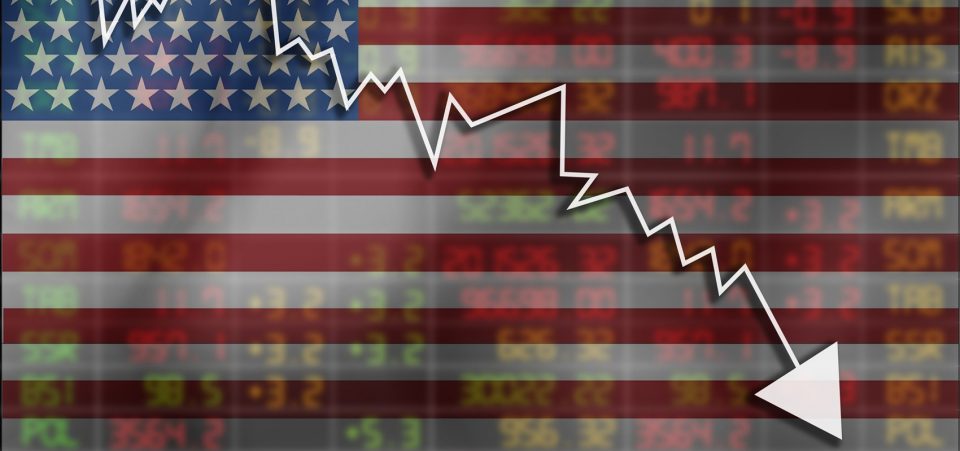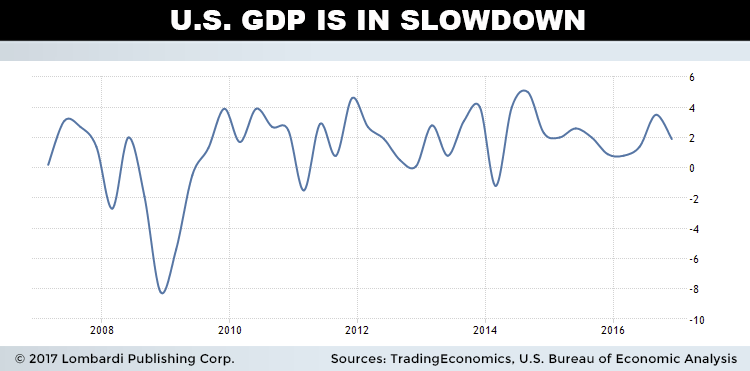Americans Have Not Realized There Is an Economic Slowdown in 2017
An economic slowdown is coming in 2017. In fact, it’s already happening. The allegedly favorable job growth numbers many had been expecting as part of a “Trump Bounce” have not happened. Rising job numbers over the first two months of the Donald Trump presidency led many to believe Trump’s “Make America Great Again” agenda would work.
But many pundits made a simple mistake. Trump settled into his new job as President on January 20. Thus, he cannot technically be given credit for the job growth. His predecessor, Barack Obama, can. Instead, those pundits might want to revise their favorable U.S. economic outlook 2017 expectations also as part of a global economic slowdown in general.
President Trump must come to terms with the fact that he’s not the CEO of America. In other words, whereas in the context of his businesses, he can take executive decisions, managing the United States requires much more compromise. The compromise takes place with other politicians, the citizens they represent, and the circumstances beyond his control.
The March job creation numbers have taught Trump a lesson about overconfidence. The economy added only 98,000 jobs last month. That’s less than half the numbers seen for the previous two months. (Source: “Job Growth Loses Steam as U.S. Adds 98,000 in March,” The New York Times, April 7, 2017.)
By the standards he set for his candidates on The Apprentice, Trump should fire himself. Some optimists said that unemployment is at 4.5%, the lowest level since after the 2007 financial crisis. But there’s something many people don’t realize about that unemployment rate. It’s always optimistic, if not all-out wrong. Note the sharp downward trend in the chart below.
The unemployment rate appears low because the government has an interest in presenting as pretty an economic picture as possible. They don’t lie about the numbers, but they do present them in a clever way that sustains optimism. The government simply avoids counting the many chronically unemployed people who may have given up looking for jobs in the period before statisticians assemble the data.
This Is What’s Causing the Economic Slowdown in 2017
This is key to understanding why there are growing chances of an economic collapse in 2017. By not counting the unemployed, they don’t affect the unemployment rate percentage. Trump himself suggested the unemployment rate was many times higher during the presidential campaign. Trump didn’t just believe it to be a few decimals higher, but a whole 35% higher, given he offered 41% as the actual rate. (Source: “Trump Said the Unemployment Rate Wasn’t Real. Here Are Some Other Options,” The New York Times, February 3, 2017.)
Therefore, should more favorable job growth statistics be produced in the next months, beware. If the percentage of the unemployed continues to fall, it is mainly because many unemployed people have been wiped off the statistics. Indeed, labor market participation rates remain at historically low levels.
In March, the proportion of the population that could claim to be actively employed but actively seeking was 63%. (Source: “US Unemployment Dips To Decadal Low,” Daily Forex, April 11, 2017.) That’s the kind of labor participation rate one might have expected in the 1960s or 70s, when fewer women were working.
Accordingly, some have suggested that the higher number of retired workers can account for the rate. But given that so many have lost savings—and many more choosing to work longer, or find part-time employment—that condition doesn’t account for much. The truth is that anyone in the age group between 25 years of age and the mid-fifties, those who are in the prime of life, are finding it difficult to maintain steady employment.
Such considerations remove much veneer from the 4.5% unemployment rate. America, like many other advanced economies, has a major problem. There is an entire generation of citizens who have had few chances to make it. Financial success for many has become an ever more elusive goal and the Trump policies alone will not make it easier to attain.
The problem has been evident for years now. The financial crisis of 2007 dragged it out in the open. The financial oligarchy—yes, the people like George Soros and Warren Buffett, but also the bankers and financial analysts on Wall Street—has little accountability. Trump wants to make them even less accountable.
President Bill Clinton deregulated the markets through the Gramm-Leach-Bliley Act of 1999. The Act repealed the Glass-Steagall Act, which the U.S. government passed in 1933 to protect the average American investor from the rapaciousness of Wall Street bankers. Ostensibly, while Wall Street suffered a few crashes in the period from 1933 to 1999, none were ever even close in fueling a recession as deep and hard as the one that ensued in after the October 1929 crash. Not until 2008 that is.
The so-called Great Recession has not yet finished dispensing its bitter medicine. The fact that so few Wall Street bankers were held accountable for the sub-prime crisis also means that they have not learned their lesson. Those who fail to learn from their mistakes, perhaps by way of remorse after being caught, are bound to make that same mistake. Those bankers and the system that Bill Clinton’s deregulation helped to create (including the 1995 Community Reinvestment Act, which encouraged the lending of mortgages to low income individuals) ruined America’s finances.
What Is the Economic Slowdown? How Will It Announce Itself?
It will take more than the Trump policies to fix that problem. The causes of the economic slowdown are directly related to the Great Recession. But, unlike pre-Clinton deregulation recessions, they linger. President Obama brought some controls against financial speculative excess. In 2010, he approved the Dodd–Frank Wall Street Reform and Consumer Protection Act.
This was Obama’s primary prescription to get the U.S. economy back on track. It’s no surprise that the authors of the Act saw Wall Street financiers as those responsible for the Great Recession, because the Act clearly aims to curb their activity.
Divided into 16 sections, over a length of 848 pages, Dodd-Frank addressed regulatory measures and increased the powers of the U.S. Securities and Exchange Commission (SEC) to oversee the rules of Wall Street. Most importantly, it aimed to reduce speculation, restricting commercial banks from investing their customers’ savings, especially in derivatives, with the Volcker rule.
President Trump wants to repeal Dodd-Frank. Doing so would please Wall Street. Bankers would have free rein to invest and take risk to a level closer to gambling than investing. Indeed, should Trump repeal the Dodd-Frank and much-needed market regulatory instruments—the economy’s equivalent of brakes on a car—the inevitable result is a major crash.
In the unregulated world of pre-2008 Wall Street—not that much has changed since then—it is difficult to distinguish the causes of the economic slowdown from the effects. They are self-perpetuating. The causes in 2007 had to do with unsustainable debt levels. A few noticed that derivatives based on toxic debt—the subprime mortgage—were worthless.
That prompted an avalanche of selling that eventually wiped out a few hundred billions off the balance sheets. In its wake, that debt destroyed the savings and pension system. Now, the risk is that the optimistic U.S. GDP forecast, expected under Trump, will not happen. Instead, the economy will be left with a less regulated financial market and the prospect of economic collapse.
Not Just Economic Slowdown, The Next Recession Will Provoke Social Breakdown
As noted above, Trump has already discussed plans to deregulate Wall Street. Meanwhile, the real economy, the one that employs people to produce GDP, is not accelerating growth. It’s holding back. In the last three months of the year, GDP slowed down to 1.9%. Recent data suggests GDP has slowed even more. The U.S. GDP rate forecast for 2017 shows that it could fall below one percent. (Source: “Macroeconomic monthly outlook: 2017 starting slow, expect US GDP below 1% gain,” FX Street, April 12, 2017.)
It would be wise for investors to prepare for an upcoming economic recession in 2017. By that, preparation certainly includes ensuring that your savings are invested in solid and reliable vehicles, rather than overly risky and volatile instruments. But, more importantly, perhaps, it involves being prepared for a frightening social breakdown.
It’s not clear what and how Trump will do what he said. He has been rather difficult to predict these days. Relations with Russia were supposed to have improved. Instead, America and Russia have not experienced the present level of tensions for decades. So, it’s anybody’s guess whether Trump will proceed with releasing the financiers on Wall Street from their regulatory chains.
Assuming that Trump will please the bankers and the other cogs in the machine of finance, the result will be a return to major financial risk-taking. That is what Wall Street wants after all. As they have proven time and again, the financial oligarchs don’t know how to control their urges. As in 1929 or 2008, the financial house of cards that speculation builds has little strength to withstand shocks to the system.
In 2008, ordinary people in America and around the world lost jobs, lost homes, lost their savings, and experienced untold litanies of problems. Bankers, months after the crash in January 2009, even gave themselves bonuses for having done such a splendid job. (Source: “Bankers Reaped Lavish Bonuses During Bailouts,” The New York Times, July 30, 2009.)
Another crash might not work out as well. It would be wise for Trump—and for Americans—to start preparing security plans for themselves, their families and property. Because, the next financial collapse will release a wave of anger that has been building for the past decade. In 1992, there were hints of what could happen with the L.A. riots.
But, in 2016, the situations in Baltimore and Ferguson raised concerns. People are angry. The next Wall Street crash that leaves the bill for average folks to pay will prompt revolt. The typical ancient Roman formula for controlling angry mobs: breads and circuses and its modern equivalent: cheap fast food and video games won’t be able to hold up the levies.
Alternatively, Trump can always find ways to engage the U.S military in a foreign intervention to distract the people with war. Perhaps, that is the plan the president has launched by antagonizing Russia. The context for a revolt is already taking shape.








